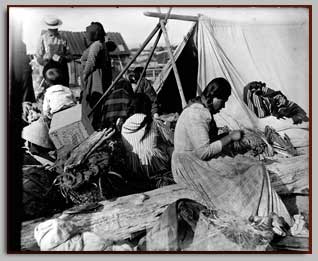Trade
 Many Ozette artifacts carry special importance. Among these are baskets that indicate contact with other tribes (probably in trade), gifts given at potlatches, and raiding. In addition, some of the baskets may have been made by wives or captives from other villages who brought to Ozette their own styles of basketry. The entire exchange of goods and techniques-and ideas-was enriching.
Many Ozette artifacts carry special importance. Among these are baskets that indicate contact with other tribes (probably in trade), gifts given at potlatches, and raiding. In addition, some of the baskets may have been made by wives or captives from other villages who brought to Ozette their own styles of basketry. The entire exchange of goods and techniques-and ideas-was enriching.
Coiled baskets within the buried houses are those made along the lower and central Fraser River of British Columbia. Some of these were found with paint in them, evidence of their use at Ozette. There also were 14 strips of coiled basketry that had been cut into strips, probably as potlatch gifts.
Cutting blankets and breaking ceremonial pieces of copper is known to have taken place at British Columbia potlatches in historic times; and the strips-including one nearly four feet long-are typical of Fraser River high-prestige pieces. At Ozette, they were found carefully stores with other valuable goods, not scattered about the house.
At least three spruce-root hats at Ozette seem to be from the north coast of British Columbia, where this material is favored for hats, and where the exact style of twining is different than along the Washington coast. There are also several carrying baskets, probably from the south or east. A certain type of rim and handles, plus beargrass overlay used for decoration, mark them as probably from the lower Olympic Peninsula or Puget Sound. These baskets were empty when found. Once they may have held dried deer meat or elk meat, or clams, perhaps traded by the basketful to the Makahs.
Several things, aside from basketry, are also quite clearly from beyond Makah territory. These include a carved D-adze handle of madrona wood and oil dishes of Oregon ash, woods that don't grow near Ozette or any other Makah village. Small round pieces of abalone shell are partly from the single species of abalone native to the Olympic Peninsula, and partly from a species no closer than Oregon. Nearly 100 red turban opercula were cached in one of the Ozette houses, most of them in the corner where the whaler evidently lived. These must represent trade or gifts, for only one or two complete shells of this snail species have come from all the rest of the deposits.
In exchange for such goods, the early Makahs probably traded-and gave-whale and seal oil, whalebone, dentalia shells, sea otter and fur seal pelts, dried halibut and other seafoods. As this is true in recent times, these early people must have exchanged some of the coastal abundance for foods and materials not really needed, but wanted. Makah lands and seas themselves provided enough for people to live well. What came from the outside were extras that made a life richer still.
^ top

